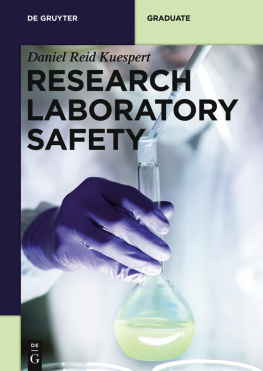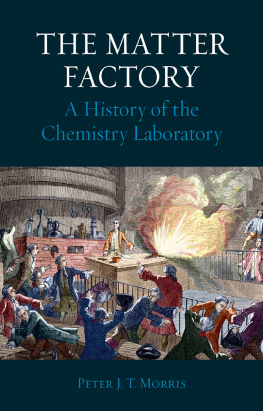Laboratory Fume Hoods Explained
Chemical Containment Exposure Control
by Chip Albright
A Creative Solutions Publication
Creative Solutions Phoenix, AZ USA
Disclaimer
This publication is designed to provide accurate and authoritative information with regard to the subject matter covered. It is sold with the understanding that the contents do not render professional advice. If you require professional assistance or expert advice, you should seek the services of a licensed professional.
Any company names, logos, or images used that are trademarked or copyrighted by others are acknowledged to be the property of the trademark or copyright owner.
Copyright 2020 Chip Albright
All rights reserved. No part of this book may be reproduced
or used in any manner without the prior written permission of the copyright owner,
except for the use of brief quotations in a book review.
To request permissions, contact the publisher at info@laboratoryfumehoodsexplained.com
Paperback: ISBN 978-1-7357110-1-0
Ebook: ISBN 978-1-7357110-4-1
First paperback edition October 2020.
Edited by Kaylene Ray
Proofreader: Rhonda Albright
Cover art by Kristen Andrews
Cover Photograph by Sunway
Photography by Lauren Albright and Chip Albright
Graphics provided by ICT
Printed in the USA
Creative Solutions
PO Box 71477
Phoenix, AZ 85850
USA
www.laboratoryfumehoodsexplained.com
Table of Contents
Introduction .....1
1 What Is A Chemical Fume Hood and Why Do We Use Them? .....4
2 What Happens When A Fume Hood Isnt Working? ....8
3 Is My Fume Hood Working? ..12
4 What Impacts Fume Hood Performance? ....15
5 What Makes A Fume Hood Work? .....24
6 Dispelling Common Myths Around Face Velocity ...29
7 Loss of Containment ...39
8 Reentrainment .42
9 Laboratory Ventilation System .47
10 The User Is A Critical Part of The System .62
11 Fume Hood Testing .......66
12 Hood Design What Makes A Great Hood? .....76
13 Classes of Hoods and Risk Management ....84
14 The Future of Fume Hoods ........96
15 The History of Fume Hoods ....120
Glossary of Terms ...127
About the Author
Chip Albright
This book is a result of a 40 plus year journey into the world of laboratories. Over those years, Chip worked for a number of industry leaders in various roles. His introduction to ventilation products started in 1985 when he was transferred to the fume hood factory of Kewaunee Scientific in Lockhart, Texas. He designed his first fume hood in the late 1980s.
After Kewaunee, he joined Jamestown-JMP in Jamestown, NY. The first ASHRAE 110 was introduced in 1985, and a major revision was released in 1995. Much had changed as a result of advancements in fume hood testing, and VAV controls, giving room for innovation. Plus, with OSHA gaining jurisdiction over laboratories, many labs that had no fume hoods were now adding them. This was the perfect time to start with a blank sheet of paper and design the best hood we could.
That fume hood was known as the Isolator and included many innovative features including the chain and axle drive system for the sash and full pan steel superstructure. This product was the beginning of a long road of innovation.
In 1999-2000 Chip was Chairman of SEFA and a driving force for the rewrite of SEFA 1- Fume Hoods. Through this time, it became apparent that there was still ample room for advancing the art of fume hoods. Chip had moved to Collegedale, LLC in TN and took on the challenge to create the next generation of fume hoods. During this time the G was developed. It was a high-performance fume hood with many advanced features. As these hoods were installed in large quantities, it became apparent that a great fume hood would only work as well as the laboratory ventilation system it was connected to. Chip developed a more holistic approach. The next few generations of the G3 focused on being more robust and capable of safe performance even on a marginal laboratory ventilation system. By 2010 it was becoming clear that there was a huge disconnect between those designing and producing fume hoods and the people who were engineering and installing laboratory ventilation systems.
Then there was that aha moment where he realized that fume hoods were not a standalone product even though that is how they were being sold. Instead they were the user interface to the mechanical ventilation system and until fume hoods became an integral part of the laboratory ventilation system, their performance was going to be questionable.
In 2008 Creative Solutions was created to explore how to best advance fume hood technology. In 2011, Chip became independent and began to explore the future of fume hoods. As a global consultant, he saw that in many parts of the world there was a total lack of understanding about how fume hoods worked and organizations were spending large amounts of money buying, installing, and operating fume hoods that were not providing an acceptable level of safety. After seeing the conditions that many users were working under, Chip became a user advocate and has spent much of the last decade educating users and laboratory managers about fume hood safety.
Lastly it became clear that because of the strong legacy of separation between fume hood manufacturers and engineers designing laboratory ventilation to achieve significant change, fume hoods were going to have to become smarter and less dependent on room conditions to perform safely. This has led to working on many innovative next generation smart fume hoods. Innovation has proven to be more accepted in countries like China and India where there is not as much resistance to change or regulation restricting innovation.
Chip has been a major player in creating standards though his work with SEFA and is a sought-after speaker on the subject of fume hood safety. His current focus is to continue to educate the market and the new generation of fume hood designers with the hope that meaningful change can take place in making laboratories truly safe for the user.
Introduction
Many laboratories have fume hoods installed. A chemical fume hood is a significant safety device that is critical to maintaining acceptable laboratory air quality and preventing user exposure to potentially harmful chemicals. Yet, the fume hood is the most misunderstood and misused safety device in the laboratory. So much mystery and myth exist regarding how a fume hood works and how to use it safely. It starts with the perception that a fume hood is a standalone device and if there is a fume hood in your laboratory and you use it, you will be safe. The reality is that a fume hood is only a small component in the mechanical ventilation system of a laboratory. It is the point of interface between the user and the laboratory ventilation system (LVS).
The fume hood does very little alone. Yes, there are good hood designs and not so good hood designs, but until connected to a properly designed and maintained laboratory ventilation system, the fume hood is just an enclosure that does nothing. The primary purpose of the fume hood is to protect users from exposure to harmful chemicals that are being used inside the hood. To do this, a fume hood must capture, contain, dilute, and exhaust those dangerous substances. None of this is possible without a ventilation system. Secondarily, the fume hood should provide some physical protection in the case of fire or explosion.











